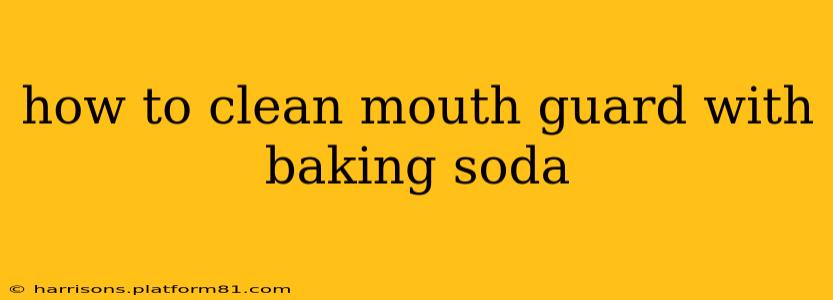Maintaining a clean mouthguard is crucial for oral hygiene and the longevity of your appliance. While many commercial mouthwash and cleaning solutions exist, baking soda offers a simple, inexpensive, and effective alternative. This guide will walk you through the process, addressing common questions and concerns.
Why Use Baking Soda to Clean a Mouthguard?
Baking soda, or sodium bicarbonate, is a mild abrasive that effectively removes bacteria, food particles, and other debris from your mouthguard's surface. Its alkaline nature helps neutralize acids, preventing the growth of odor-causing microorganisms. This natural cleaning power makes it a popular and safe option for many dental appliances.
How to Clean a Mouthguard with Baking Soda: A Step-by-Step Guide
Materials You'll Need:
- Your mouthguard
- Baking soda
- A soft-bristled toothbrush
- Warm water
- A clean bowl or container
Steps:
- Rinse: First, rinse your mouthguard thoroughly under warm running water to remove loose debris.
- Prepare the Baking Soda Solution: In your bowl, mix a small amount of baking soda (about a teaspoon) with enough warm water to create a paste. The consistency should be similar to toothpaste.
- Apply and Scrub: Apply the baking soda paste to your toothbrush. Gently scrub all surfaces of your mouthguard, paying particular attention to areas where plaque and bacteria tend to accumulate.
- Rinse Thoroughly: Rinse your mouthguard again under warm running water, ensuring all traces of the baking soda paste are removed.
- Air Dry: Allow your mouthguard to air dry completely before storing it in its case. Avoid using a towel to dry it, as this can introduce lint or bacteria.
How Often Should I Clean My Mouthguard with Baking Soda?
For optimal hygiene, it's recommended to clean your mouthguard with baking soda at least once a day, ideally after each use. More frequent cleaning may be necessary depending on your activity level and the amount of saliva and debris that accumulates on the mouthguard.
Can I Use Baking Soda on All Types of Mouthguards?
While baking soda is generally safe for most mouthguards, it's crucial to check the manufacturer's instructions. Some mouthguards may be made of materials that could be damaged by abrasive cleaning methods. If you're unsure, opt for a gentler cleaning method or contact your dentist or orthodontist.
What if My Mouthguard Still Smells Bad After Cleaning with Baking Soda?
If your mouthguard continues to smell bad even after cleaning with baking soda, several factors could be contributing:
- Insufficient Cleaning: Ensure you're cleaning all surfaces thoroughly and removing all traces of baking soda.
- Deep-Seated Bacteria: Prolonged use can lead to bacteria embedding into the material. Soaking the mouthguard in a mild mouthwash solution might help.
- Material Degradation: If your mouthguard is old or damaged, the material itself might be retaining odors. Consider replacing it.
Can I Use Baking Soda with Other Cleaning Agents?
You can combine baking soda with other cleaning agents, but proceed with caution. Avoid mixing it with strong chemicals like bleach, as this can be harmful to your mouthguard and potentially dangerous. A mild mouthwash can be a suitable addition to enhance cleaning.
What are other ways to clean my mouthguard?
Besides baking soda, you can also clean your mouthguard using specialized mouthguard cleaning tablets or solutions, a denture cleaner, or simply warm soapy water. Always refer to the manufacturer's instructions for your specific mouthguard type.
By following these simple steps and addressing potential concerns, you can maintain a clean and fresh-smelling mouthguard, promoting optimal oral hygiene and ensuring your appliance lasts longer. Remember, regular cleaning is key to preventing the build-up of bacteria and maintaining a healthy mouth.
